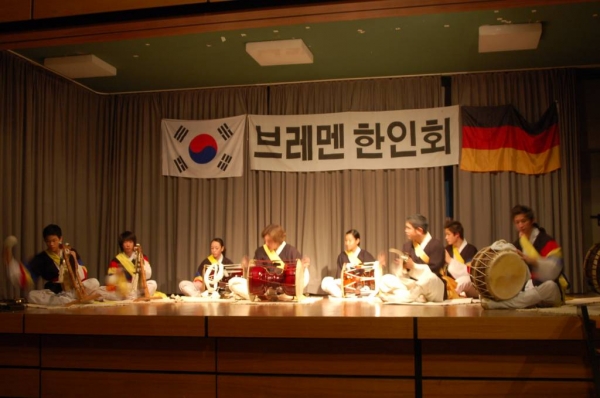- Samul nori
caption=A "samul nori" performance in Bremen, Germany
hangul=사물놀이
hanja=놀이
rr=Samullori "or" Samul nori
mr=Samullori "or" Samul noriSamul nori is a genre of traditional
percussion music originating inKorea . The word "samul" means "four objects" and "nori" means "play"; samul nori is always performed with fourtraditional Korean musical instruments :* "
Kkwaenggwari " (a smallgong )
* "Jing" (a larger gong)
* "Janggu " (an hourglass-shapeddrum )
* "Buk" (abarrel drum similar to thebass drum )The traditional Korean instruments are called "
pungmul ".Samul nori has its roots in "
nong-ak " (literally "farmers' music"), a Korean folk genre comprising music,acrobatics , folk dance, and rituals, which was traditionally performed inrice farming villages in order to ensure and to celebrate good harvests. Specifically, samul nori music derives from "utdari pungmul" (the "gut", or shaman ceremony rhythm of theGyeonggi-do andChungcheong provinces ofSouth Korea ), as well as the genres ofYeongnam folk music andHonam "udo gut", combined with more contemporary improvisations, elaborations, and compositions. [http://www.lifeinkorea.com/culture/samul/samul.cfm?Subject=history] Such "nong-ak" is steeped in traditionalanimism and shamanism, but also shows influences fromKorean Buddhism . While "nong-ak" often features the use of wind instruments, "samul nori" only features the aforementioned four percussion instruments.Each of the four instruments represents a different weather condition: the "janggu" represents rain, the "kkwaenggwari" thunder, the "jing" the sounds of the wind, and the "buk" clouds. The idea of
yin and yang is also reflected in these instruments: the "buk" and "janggu" (leather) represent the sounds of the earth, while the "jing" and "kkwaenggwari" (metal) represent sounds of the heavens. Although generally performed indoors, as a staged genre, samul nori depicts the traditional Korean culture, an agricultural society rooted in the natural environment.Fact|date=February 2007 Samul nori is characterized by strong, accented rhythms, vibrant body movements, and an energetic spirit.Samul nori has gained international popularity, with many samul nori bands and camps worldwide. Since the 1980s in South Korea, there has been a marked increase in the amount of fusion music, combining samul nori and Western instruments.Fact|date=February 2007
The most famous samul nori ensemble is the internationally famous South Korean ensemble called SamulNori, which is credited for bringing the music from a rural folk genre to the contemporary stage. [ [http://english.kbs.co.kr/society/people/1340388_11774.html Kbs Global ] ] The group was established in February 1978 by "janggu" player and former
Namsadang star performerKim Duk Soo ( _ko. 김덕수 [http://www.art.go.kr/vli_dir/vli_dir08_pop_detail.jsp?ar_vvm_cd_seq=8754] ), [http://www.nanjangcultures.com/english/biography.asp] with the remaining original performers being Kim Young Bae ("kkwaenggwari"), Choi Tae Hyun ("jing"), and Lee Jong Dae ("buk"). Following Kim Young Bae's death in 1985, he was replaced by Choi Jong Sil, and Lee Kwang Soo replaced Lee Jong Dae on the "buk". [http://www.lifeinkorea.com/culture/samul/samul.cfm?Subject=history] The group has collaborated and recorded with a number of non-Korean ensembles, most notably in 1987 with the Red Sun jazz band, with one SamulNori/Red Sun CD selling 70,000 copies. [http://www.asiaweek.com/asiaweek/magazine/nations/0,8782,165862,00.html] [http://times.hankooki.com/lpage/culture/200610/kt2006101117513511690.htm] [http://www.allmusic.com/cg/amg.dll?p=amg&sql=10:lza9kextkq7b] They have also performed (in August 2000 at the Earth Celebration International Arts Festival on Sado Island inJapan ) with the Japanesetaiko group Kodo. [http://www.outdoorjapan.com/features/ojfeature-ec2000.html]About his choice to move from the more traditional outdoor performances to indoor venues, Kim Duk Soo states that at the time he established SamulNori, during the last years of the administration of former South Korean president
Park Chung Hee , Korean traditional music was associated with the student movement, and anyone playing such instruments outdoors could be arrested. Thus, he developed the current version of the genre, which is generally presented indoors, on concert hall stages. [http://english.seoul.go.kr/today/infocus/interview/1236715_5099.php]In 1993, SamulNori expanded to include twenty performers, and changed its name to SamulNori Hanullim, Inc. ("Hanullim" meaning "big bang"). [ [http://www.lifeinkorea.com/culture/samul/samul.cfm?Subject=history] [http://english.kbs.co.kr/society/people/1340388_11774.html] ]
References
External links
* [http://english.kbs.co.kr/society/people/1340388_11774.html Article about the history of samul nori]
* [http://www.poongmul.com/ Poongmul in the U.S.]
* [http://www.kycc.net/NPN/ Information about Pungmul and Pungmul in the U.S.]
* [http://www.samulnori.eu European samul nori website]
* [http://www.samulnori.de German samul nori website]
* [http://www.allianceartistmanagement.com/artist.php?id=samulnori&aview=bio SamulNori artist page] from Alliance Artist Management
* [http://english.seoul.go.kr/today/infocus/interview/1236715_5099.php Interview with Kim Duk Soo about SamulNori]
Wikimedia Foundation. 2010.

